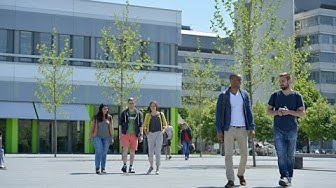- Student-faculty ratios: 77.5
- Male to female ratio: 57 : 43
- School nature: Public
- Website: http://www.uni-bielefeld.de/(en)/
- Address: Universitätsstraße 25,Bielefeld, 33615,Germany
- Phone: +49 521 106 00
Bielefeld University Research, teaching, and studying on an interdisciplinary, communicative, and inspiring campus. Bielefeld University – founded in 1969 – hosts 13 faculties covering a range of subjects in the humanities, natural sciences, social sciences, and technology. As an internationally oriented university, it combines a strong focus on research with a particular emphasis on top-quality teaching. More than 24,255 students are enrolled in more than 100 different course options, and the University employs approximately 2,750 staff, including 1,650 academic researchers and teachers. Research Interdisciplinary top-ranking research: internationally networked and recognized throughout the world. In relevant and focused areas covering the humanities and social sciences along with the natural and engineering sciences, Bielefeld University is one of the top research universities in Germany. Four main research fields are committed to carrying out research and promoting young academics on a top international level within the framework of first-class interdisciplinary collaborative research projects, central academic institutes, and systematic individual funding. The university’s exceptional research performance is underlined in a host of ways by, for example, the Excellence Initiative (Cluster, Graduate School), Collaborative Research Centres (SFB), DFG Research Units, ERC grants, Heisenberg Professorships, and participation in the German Federal Ministry of Research and Education‘s ‘it’s OWL’ technology network. Bielefeld University’s research strengths are confirmed regularly in rankings such as the German Research Foundation’s (DFG) Funding Atlas, the Centre for Higher Education’s CHE Research Ranking, or the Humboldt Rankings of popularity among international visiting academics. Teach Innovative structures and projects, platforms for exchanging information, a wide range of further training options, and an inspiring teaching climate. Teaching at Bielefeld University is characterized by a broad, differentiated, and interdisciplinary range of highly networked courses. What makes it so special is the way in which numerous combinations are possible within a standard Bachelor degree programme framework. A broad range of Master’s degree programmes, some involving cooperations between several faculties, offer attractive options for studying one subject in more depth or linking together different subjects. The guiding principle is to offer a structure that makes it possible for students to design their own individual study course, that motivates them to become actively involved in their subjects, and that promotes independent learning and academic curiosity. Bielefeld University does not just impart the necessary specialized knowledge for future careers but teaches its students fundamental analytical skills and interdisciplinary competencies. Study A range of different degree programmes, individually combinable, backed up by service and counselling – all on one modern campus. At Bielefeld University, students can choose between a great number of courses. They can concentrate on one single subject, choose a teacher-training course, or put together their own choice of interdisciplinary subjects. Individual subsidiary subjects enable students to pursue their own personal interests. The degree programmes are supplemented by comprehensive services and counselling facilities, one of the best university libraries in Germany, a modern study infrastructure, comprehensive language courses, and a wide range of university-level sport facilities. The closely interlinked campus buildings encourage students to exchange information, meet each other, and become involved in university life. Major rankings such as the Centre for Higher Education (CHE) University Ranking repeatedly confirm the quality of studying and teaching at Bielefeld University. Living on campus Individual freedom and an easy-going atmosphere simply go hand in hand with the university’s unusual architecture. In particular, the central hall’s numerous recreational spaces and shopping facilities provide a lively communicative forum for daily university work. A broad range of cultural events and sport facilities offer a break from the lecture hall and the workplace. Researchers, teachers, post-grads, and students from all over the world contribute to the international flair of the campus. Living in Bielefeld A metropolis full of green parks with a lively and varied cultural life. The city of Bielefeld is one of the twenty biggest cities in Germany, with a population of almost 330,000. This lively university city on the edge of the Teutoburg Forest is the region‘s cultural and intellectual hub. East Westphalia-Lippe is Germany’s fifth-largest economic area and the region is home to two million people. What our international students say Lilit from Armenia, student of Interdisciplinary Media Studies (M.A.) “What I love about Bielefeld University is that we have the possibility to gain practical experience. In my study course, we produce short films and audio books. This is a really great opportunity for my future career!” Matt from the USA, student of Inter-American Studies "My experience in Bielefeld has been extremely positive. It has been an opportunity to understand another culture and system of education. I have been really impressed by the quality of professors and the abilities of my peers (both German and international) as well as the opportunities presented to students here." Nora from the United States, student of Inter-American Studies "I love studying at Bielefeld University. It was very easy to make a community, meet friends, get involved in activities, and participate in extracurriculars. The level of my study program is very high. The professors are very knowledgeable and helpful – they are always there to help or offer support to students. I was also able to become involved in sports and dance programs here and meet German students. I would highly recommend studying at Bielefeld University." Sayandev from India, student of Intelligent Systems (M.A.) “Bielefeld University has great research facilities and teaching staff. Bielefeld is a great place for students!” Mailing addressBielefeld UniversityUniversitätsstraße 25D-33615 Bielefeldwww.uni-bielefeld.de/(en)/index.html Do you have any questions? We can help. International Office (IO)For international students or questions about studying abroad Contact us
- Total number of students 24,255
- Number of international students 1,845
- Total number of academic staff 377
- Number of international staff 22
- Number of undergraduate degrees awarded 1,739
- Number of master's degrees awarded 1,429
- Number of doctoral degrees awarded 203
- Number of research only staff 140
- Number of new undergraduate students 5,172
- Number of new master's students 2,271
- Number of new doctoral students 271
- Global score 45.6
- Global research reputation #443
- Regional research reputation #202
- Publications #638
- Books #239
- Conferences #720
- Normalized citation impact #457
- Total citations #571
- Number of publications that are among the 10 percent most cited #591
- Percentage of total publications that are among the 10 percent most cited #588
- International collaboration #768
- Percentage of total publications with international collaboration #386
- Number of highly cited papers that are among the top 1 percent most cited #599
- Percentage of highly cited papers that are among the top 1 percent most cited #605
*The above data comes from: Official website of U.S.News
-

77.5
No. of students per staff
-

8%
Percentage of International Students
-

57 : 43
Student Ratio of Females to Males
-

24,875
Number of FTE Students
*The above data comes from: Official website of TIMES
-
World University Rankings
-
2011
173
-
2012
251-275
-
2013
276-300
-
2014
301-350
-
2015
351-400
-
2016
251-300
-
2017
251—300
-
2018
251–300
-
2019
201–250
-
2020
=166
-
-
Young University Rankings
-
2012
42
-
2013
40
-
2014
51
-
2015
57
-
2016
23
-
2017
22
-
2018
29
-
2019
=20
-
-
Arts & humanities
-
2018
201–250
-
2019
201–250
-
-
Engineering & technology
-
2011
49
-
-
Life sciences
-
2018
251–300
-
2019
301–400
-
-
Physical sciences
-
2018
301–400
-
2019
401–500
-
-
Social sciences
-
2018
126–150
-
2019
151–175
-
-
Business & Economics
-
2019
301–400
-
-
Computer Science
-
2018
201–250
-
2019
301–400
-
-
Education
-
2019
101–125
-
-
Psychology
-
2019
251–300
-
-
European Teaching
-
2018
151-200
-
2019
151-200
-
*The above data comes from: Official website of TIMES
-
#366 Biology and Biochemistry
Show ranking metrics under this major
- Biology and Biochemistry overall score 29.2
- Biology and Biochemistry global research reputation #409
- Biology and Biochemistry regional research reputation #180
- Biology and Biochemistry publications #380
- Biology and Biochemistry normalized citation impact #135
- Biology and Biochemistry total citations #301
- Biology and Biochemistry number of publications that are among the 10 percent most cited #260
- Biology and Biochemistry percentage of total publications that are among the 10 percent most cited #102
- Biology and Biochemistry international collaboration #478
- Biology and Biochemistry percentage of total publications with international collaboration #229
- Biology and Biochemistry number of highly cited papers that are among the top 1 percent most cited #234
- Biology and Biochemistry percentage of highly cited papers that are among the top 1 percent most cited #153
-
#151 Mathematics
Show ranking metrics under this major
- Mathematics overall score 48.0
- Mathematics global research reputation #134
- Mathematics regional research reputation #102
- Mathematics publications #139
- Mathematics normalized citation impact #174
- Mathematics total citations #157
- Mathematics number of publications that are among the 10 percent most cited #134
- Mathematics percentage of total publications that are among the 10 percent most cited #145
- Mathematics international collaboration #65
- Mathematics percentage of total publications with international collaboration #58
- Mathematics number of highly cited papers that are among the top 1 percent most cited #257
- Mathematics percentage of highly cited papers that are among the top 1 percent most cited #290
-
#507 Physics
Show ranking metrics under this major
- Physics overall score 41.2
- Physics global research reputation #313
- Physics regional research reputation #130
- Physics publications #574
- Physics normalized citation impact #486
- Physics total citations #566
- Physics number of publications that are among the 10 percent most cited #539
- Physics percentage of total publications that are among the 10 percent most cited #469
- Physics international collaboration #594
- Physics percentage of total publications with international collaboration #448
- Physics number of highly cited papers that are among the top 1 percent most cited #543
- Physics percentage of highly cited papers that are among the top 1 percent most cited #510
-
#279 Plant and Animal Science
Show ranking metrics under this major
- Plant and Animal Science overall score 44.2
- Plant and Animal Science global research reputation #310
- Plant and Animal Science regional research reputation #125
- Plant and Animal Science publications #423
- Plant and Animal Science normalized citation impact #94
- Plant and Animal Science total citations #300
- Plant and Animal Science number of publications that are among the 10 percent most cited #279
- Plant and Animal Science percentage of total publications that are among the 10 percent most cited #121
- Plant and Animal Science international collaboration #347
- Plant and Animal Science percentage of total publications with international collaboration #178
- Plant and Animal Science number of highly cited papers that are among the top 1 percent most cited #187
- Plant and Animal Science percentage of highly cited papers that are among the top 1 percent most cited #82
-
#341 Social Sciences and Public Health
Show ranking metrics under this major
- Social Sciences and Public Health overall score 32.1
- Social Sciences and Public Health global research reputation #220
- Social Sciences and Public Health regional research reputation #96
- Social Sciences and Public Health publications #375
- Social Sciences and Public Health normalized citation impact #370
- Social Sciences and Public Health total citations #381
- Social Sciences and Public Health number of publications that are among the 10 percent most cited #400
- Social Sciences and Public Health percentage of total publications that are among the 10 percent most cited #415
- Social Sciences and Public Health international collaboration #311
- Social Sciences and Public Health percentage of total publications with international collaboration #211
- Social Sciences and Public Health number of highly cited papers that are among the top 1 percent most cited #339
- Social Sciences and Public Health percentage of highly cited papers that are among the top 1 percent most cited #285







